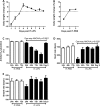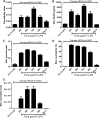Using a non-invasive assessment of lung injury in a murine model of acute lung injury
- PMID: 25478170
- PMCID: PMC4212707
- DOI: 10.1136/bmjresp-2013-000014
Using a non-invasive assessment of lung injury in a murine model of acute lung injury
Abstract
Arterial oxygen saturation has not been assessed sequentially in conscious mice as a direct consequence of an in vivo murine model of acute lung injury. Here, we report daily changes in arterial oxygen saturation and other cardiopulmonary parameters by using infrared pulse oximetry following intratracheal lipopolysaccharide (IT-LPS) for up to 9 days, and following IT-phosphate buffered saline up to 72 h as a control. We show that arterial oxygen saturation decreases, with maximal decline at 96 h post IT-LPS. Blood oxygen levels negatively correlate with 7 of 10 quantitative markers of murine lung injury, including neutrophilia and interleukin-6 expression. This identifies infrared pulse oximetry as a method to non-invasively monitor arterial oxygen saturation following direct LPS instillations.
Keywords: Neutrophil Biology; Pulmonary oedema; Respiratory Infection.
Figures




Similar articles
-
Comparative Analysis of Oxygen Saturation by Pulse Oximetry and Arterial Blood Gas in Hypoxemic Patients in a Tertiary Care Hospital.Cureus. 2023 Jul 25;15(7):e42447. doi: 10.7759/cureus.42447. eCollection 2023 Jul. Cureus. 2023. PMID: 37637606 Free PMC article.
-
Pulse oximetry at two sensor placement sites in conscious foals.Acta Vet Scand. 2025 Jan 23;67(1):6. doi: 10.1186/s13028-025-00794-w. Acta Vet Scand. 2025. PMID: 39849542 Free PMC article.
-
[Standard technical specifications for methacholine chloride (Methacholine) bronchial challenge test (2023)].Zhonghua Jie He He Hu Xi Za Zhi. 2024 Feb 12;47(2):101-119. doi: 10.3760/cma.j.cn112147-20231019-00247. Zhonghua Jie He He Hu Xi Za Zhi. 2024. PMID: 38309959 Chinese.
-
Retinal oximetry and systemic arterial oxygen levels.Acta Ophthalmol. 2018 Nov;96 Suppl A113:1-44. doi: 10.1111/aos.13932. Acta Ophthalmol. 2018. PMID: 30460761 Review.
-
Arterial Oxygen Saturation: A Vital Sign?Niger J Clin Pract. 2023 Nov 1;26(11):1591-1594. doi: 10.4103/njcp.njcp_2026_21. Epub 2023 Dec 4. Niger J Clin Pract. 2023. PMID: 38044759 Review.
Cited by
-
Pore-forming activity of S. pneumoniae pneumolysin disrupts the paracellular localization of the epithelial adherens junction protein E-cadherin.Infect Immun. 2023 Sep 14;91(9):e0021323. doi: 10.1128/iai.00213-23. Epub 2023 Aug 21. Infect Immun. 2023. PMID: 37607057 Free PMC article.
-
IL-33-mediated Eosinophilia Protects against Acute Lung Injury.Am J Respir Cell Mol Biol. 2021 May;64(5):569-578. doi: 10.1165/rcmb.2020-0166OC. Am J Respir Cell Mol Biol. 2021. PMID: 33571420 Free PMC article.
-
Blocking HXA3-mediated neutrophil elastase release during S. pneumoniae lung infection limits pulmonary epithelial barrier disruption and bacteremia.mBio. 2024 Sep 11;15(9):e0185624. doi: 10.1128/mbio.01856-24. Epub 2024 Aug 9. mBio. 2024. PMID: 39120139 Free PMC article.
-
BMJ Open Respiratory Research: 1 year on.BMJ Open Respir Res. 2015 Jan 22;2(1):e000077. doi: 10.1136/bmjresp-2014-000077. eCollection 2015. BMJ Open Respir Res. 2015. PMID: 25671133 Free PMC article. No abstract available.
-
High glucose levels increase influenza-associated damage to the pulmonary epithelial-endothelial barrier.Elife. 2020 Jul 22;9:e56907. doi: 10.7554/eLife.56907. Elife. 2020. PMID: 32697191 Free PMC article.
References
-
- Rubenfeld GD, Caldwell E, Peabody E, et al. . Incidence and outcomes of acute lung injury. N Engl J Med 2005;353:1685–93 - PubMed
-
- Tapping RI, Akashi S, Miyake K, et al. . Toll-like receptor 4, but not toll-like receptor 2, is a signaling receptor for escherichia and salmonella lipopolysaccharides. J Immunol 2000;165:5780–7 - PubMed
Grants and funding
LinkOut - more resources
Full Text Sources
Other Literature Sources
